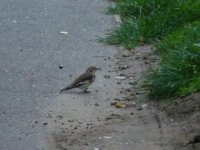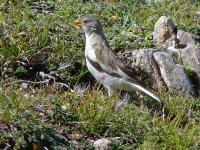Songkhran
Well-known member
They say lightning never strikes twice in the same place....
I planned to meet up with a mate at Cley coastguards this morning at 09:00am. I was not expecting the seawatching to be much good with light sw winds. But with nothing else much happenening it was something to do.
Visibility was good but a bit hazy on the horizon.
I was pleasantly surprised to learn that there had already been a few Manx through. Plenty of juv Gannet passed close. For the next hour or so there were plenty of birds to keep us occupied, up to six more Manx, A couple of Juv Pom(west), Artics and Bonxies. A good passage of Rt Divers with a few Black Throated seen too, (surprisingly early?).
At approx 10:50hrs I was scanning the horizon and picked up on a suspected fulmar flying away east on the horizon. I tracked this bird along to about my 2 o'clock postion, when i saw a bird cross its path coming the other way, westwards.
My first thoughts were instantly large Sheawater as its flight action resembled in my experience Cory's in the meditteranean. Extremely high, tight arcs, once down the bird came straight up again in another high arc forming a continuous stream of ms if you like.
The wings, quite straight were long and narrow, making the wingspan easily twice the legth of the body.
The bird displayed a shining white belly to tail, but the underwings were dark grey. Unfortunately the bird was at such distance on the horizon I was unable to discern the white extending up onto the under wing coverts nor were the dark grey upperparts noticeably contrasting enough to form a v shape. The birds track was such that after watching it for a very slow 4 minutes(ish) it was lost to view over the horizon. Suggestions Guys?
presumably it 'felt' different from large shear and thats why you are mentioning it. Maybe if you go on and bird Madeira you'll have that instantly feeling of recognition. Enjoy the frustration of what could have been, enjoy the experience of having possibly seen a great bird in rubbish winds





